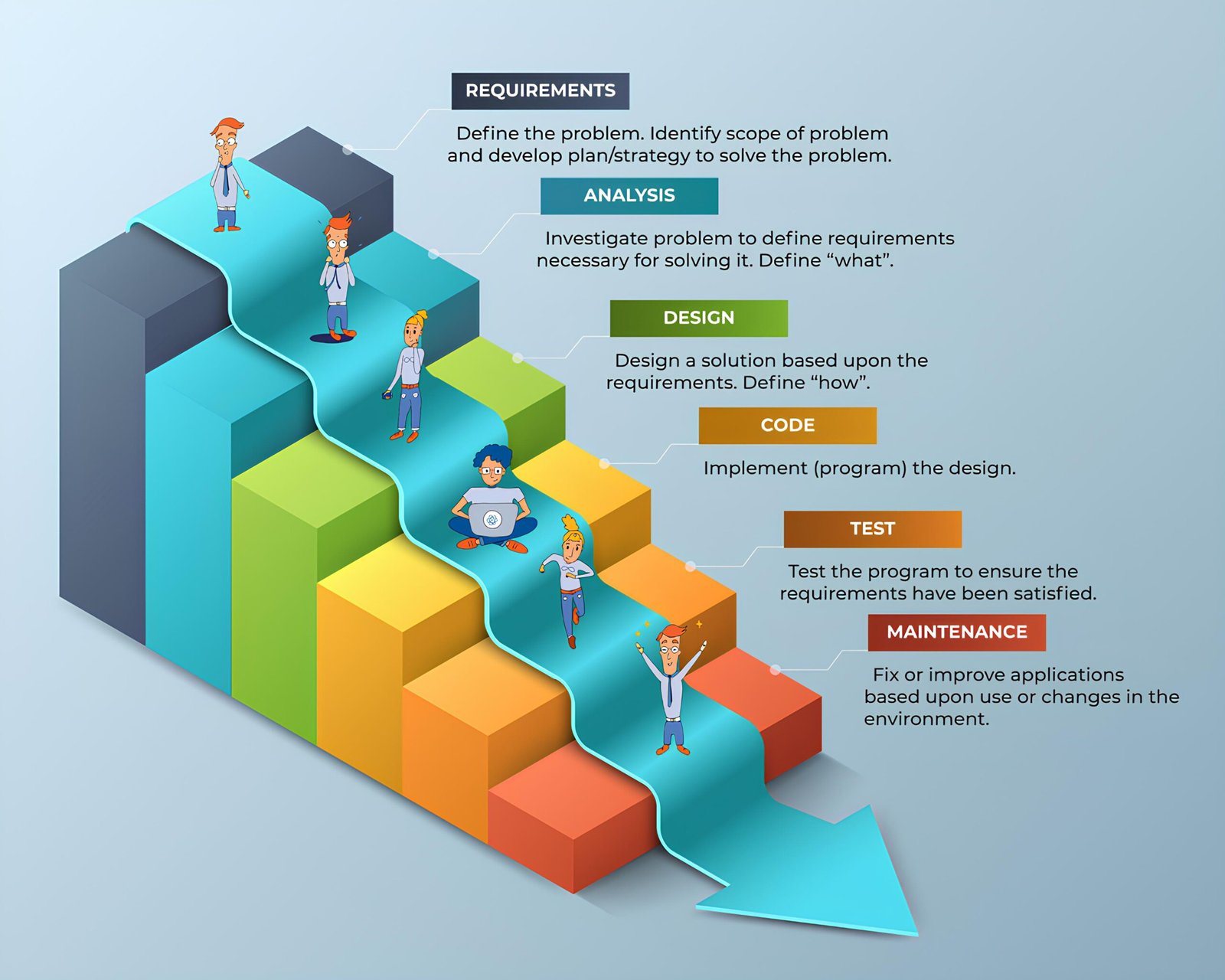Website Maintenance Best Practices for 2024
Maaz Khalid
May 12, 2024

In the ever-evolving digital landscape of 2024, website maintenance emerges as a critical component for businesses and individuals alike wanting to safeguard their online presence and ensure continued success. With the rapid pace of technological advancements and fluctuating SEO trends, neglecting website maintenance can lead to decreased visibility, lower search rankings, and, ultimately, a reduction in user engagement and conversion rates. Maintaining a website is no longer a once-off task but a continuous process of updates, optimizations, and checks to stay ahead of competitors and meet the ever-changing user expectations.
This article delves into the importance of website maintenance, exploring its various types and the key tasks involved. It provides a comprehensive guide on setting up a structured maintenance schedule, selecting the best tools for website maintenance, and navigating common challenges that web administrators face. Additionally, it discusses the benefits of hiring professional website maintenance services for businesses lacking the time or expertise to manage their web maintenance needs effectively. By adhering to the best practices outlined herein, website owners and managers can ensure their sites remain reliable, secure, and aligned with the latest SEO strategies and digital standards.
Why Website Maintenance Is Important
Regular website maintenance is essential for multiple reasons, each playing a vital role in the overall success and efficiency of an online presence.
Impact On User Experience
A well-maintained website ensures an optimal user experience by facilitating smooth navigation and fast loading times. Regular updates and checks help prevent issues like broken links and outdated information, which can frustrate users and lead to a negative perception of the brand. By maintaining a website, businesses ensure that users have a positive interaction each time they visit, which is essential for building customer loyalty and increasing user retention.
SEO Benefits
Search engines prioritize websites that are consistently updated with new and pertinent content. This practice not only helps in maintaining a higher visibility in search engine results but also improves the website’s SEO performance. Regular maintenance signals to search engines that the website is active, enhancing its likelihood of ranking well. This is crucial for attracting organic traffic, which can lead to increased engagement and conversions.
Security Implications
In the current digital era, security is of utmost importance. Regular maintenance includes updating security measures and patching vulnerabilities, which are critical in protecting a website against cyber threats. Keeping a website secure maintains the trust of users and protects sensitive data, which is particularly important for websites handling transactions and personal information.
Business Reputation
The state of a website reflects directly on the brand it represents. Regular maintenance ensures that the website operates flawlessly and stays aesthetically pleasing, projecting a professional image. This is vital for maintaining and enhancing the brand’s reputation, as a well-maintained website communicates reliability and commitment to quality to its users.
By adhering to these best practices in website maintenance, businesses can ensure their website remains functional, secure, and competitive in the ever-evolving digital landscape.
Types Of Website Maintenance
Website maintenance is a crucial aspect of managing an online presence, ensuring that a website remains functional, secure, and up-to-date. There are primarily two types of maintenance strategies employed: Manual Maintenance and Automated Maintenance Services, each serving unique purposes and offering different benefits.
Manual Maintenance
Manual maintenance involves human intervention to handle various tasks such as updating content, fixing broken links, and performing usability tests. This type of maintenance is particularly valuable for addressing complex issues that require a nuanced understanding of the user experience and for making bespoke adjustments to the website. Manual testing allows for a detailed inspection of the website’s functionality, ensuring that all features operate as intended and providing a personal touch that automated tools cannot replicate. It includes activities like exploratory testing, where testers actively explore the application without predefined test cases, and ad-hoc testing for quick, one-off problem-solving. Manual maintenance is essential for tasks that require creativity, intuition, and human judgment, making it indispensable for ensuring a high-quality user experience.
Automated Maintenance Services
Automated maintenance, on the other hand, utilizes software tools and scripts to perform repetitive tasks such as security updates, backups, and performance monitoring. This approach enhances efficiency and consistency, reducing the likelihood of human error and allowing for continuous operations without requiring constant manual oversight. Automated tests can cover extensive areas quickly and are ideal for regression testing, where the goal is to confirm that recent changes have not adversely affected existing functionalities. Furthermore, automated maintenance includes real-time monitoring of website performance, ensuring that any issues are promptly detected and addressed. This type of maintenance is particularly effective for large-scale operations requiring high levels of accuracy and speed.
Both manual and automated maintenance are integral to a comprehensive website maintenance strategy. By combining the detailed attention of manual maintenance with the efficiency of automated services, businesses can ensure their websites are not only operational and secure but also optimized for the best possible user experience.
Key Website Maintenance Tasks
Maintaining a website effectively involves a variety of crucial tasks that ensure the site remains functional, secure, and optimized for both search engines and user experience. Here are some key website maintenance tasks categorized under essential subheadings:
Content Updates
Regularly updating content is vital to keep a website relevant and engaging. This includes refreshing blog posts, revising outdated information, and ensuring all content aligns with current SEO strategies. Statistics from Hubspot indicate that updating old blog posts with new content and images can increase organic traffic significantly, by as much as 106%.

SEO Checks
SEO maintenance is critical for ensuring a website remains visible and competitive in search engine rankings. This involves regular reviews and optimizations of on-page SEO elements, content relevance, and keyword density. Monitoring backlinks and internal linking structures also plays a crucial role in maintaining SEO health, thereby sustaining or improving search engine rankings.
Performance Optimization
Optimizing website performance is essential for enhancing user experience and reducing bounce rates. Key strategies include compressing images, minifying CSS and JavaScript, and reducing the number of HTTP requests. Implementing caching solutions and a Content Delivery Network (CDN) can significantly improve load times, especially for websites with a global audience.
Security Measures
With the increasing prevalence of cyber threats, maintaining robust security protocols is non-negotiable. This includes regular updates to software and plugins, implementing strong password policies, and conducting frequent security audits. Utilizing tools like Web Application Firewalls (WAF) and SSL encryption helps protect against potential breaches and enhances user trust.
Website Backups
Regular backups are a safety net for any website, ensuring quick recovery in the event of data loss or a cyber-attack. It’s advisable to perform backups frequently and store them in multiple, secure off-site locations. This practice not only protects data but also ensures that the latest version of the website can be restored with minimal downtime.
By adhering to these key maintenance tasks, website owners and administrators can ensure their sites operate efficiently, remain secure, and provide a positive user experience, thereby supporting business goals and digital presence.
Setting Up A Maintenance Schedule
Establishing a structured maintenance schedule is essential for the ongoing health and performance of any website. By categorizing tasks into daily, weekly, and monthly activities, website administrators can ensure consistent operation and minimize potential disruptions. Here’s how to organize these tasks effectively:
Daily Tasks
Daily maintenance tasks are crucial for immediate issues that could affect website functionality and user experience. Key daily tasks include:
- Backup Checks: Verify that automatic backups are functioning correctly to ensure data integrity.
- Security Scans: Conduct daily security checks to detect and mitigate potential threats, keeping the website safe from vulnerabilities.
Weekly Tasks
Weekly maintenance tasks focus on operational continuity and content vitality. They include:
- Software and Plugin Updates: Regular updates to CMS and plugins help protect against new vulnerabilities and ensure the website runs smoothly.
- Link and Form Checks: Weekly reviews of all site links and forms prevent user frustration from broken links or non-functioning forms, which could impact lead generation.
- Content Updates: Posting new blogs or updating existing content can boost SEO and keep the website engaging for returning visitors.
Monthly Tasks
Monthly tasks are broader and aim at long-term performance and strategic alignment. These tasks include:
- Performance Reviews: Utilize tools like GTmetrix to analyze page load speeds and adjust as necessary to improve user experience.
- SEO and Content Analysis: Review search engine visibility and content engagement metrics to refine SEO strategies and update content.
- Comprehensive Audits: Run thorough checks on the website’s security, performance, and overall health to ensure it aligns with current web standards and business goals.
By adhering to this structured schedule, businesses can maintain a robust online presence, enhancing both user satisfaction and operational efficiency.
Best Tools For Website Maintenance
Selecting the right tools for website maintenance is crucial for optimizing performance, enhancing security, and improving search engine optimization (SEO). Below are some of the top tools categorized by various maintenance requirements:
SEO Tools
SEO tools are essential for enhancing a website’s visibility and search engine ranking. Tools like Screaming Frog offer comprehensive site crawling capabilities to identify issues such as duplicate content and broken links. Semrush and SE Ranking provide all-in-one solutions, encompassing keyword optimization, competition monitoring, and site health improvements. These tools automate complex SEO tasks, making them essential for both novices and experienced marketers.
Performance Monitoring
For maintaining optimal website performance, tools like Cloudflare and Dareboost are highly effective. Cloudflare’s CDN services ensure fast content delivery globally, while Dareboost provides insights into factors affecting site speed and security. Real User Monitoring (RUM) and Synthetic Monitoring tools like Dynatrace and Pingdom offer detailed analytics on user interactions and site functionality, helping to preemptively address potential issues.
Security Scanners
Security is a top priority for any website. Tools such as Intruder and Acunetix scan for vulnerabilities, offering detailed reports and actionable insights to enhance security measures. These tools support a variety of scanning methods, including DAST and IAST, which help in identifying real-time threats and ensuring robust security against cyber attacks.
Backup Solutions
Frequent backups are crucial for maintaining data integrity and ensuring recovery. Cloud backup solutions like UpdraftPlus and BackupBuddy provide automated services to safeguard data across multiple platforms and devices. These tools ensure that data is not only backed up regularly but also easily retrievable in case of data loss or a security breach.
By integrating these tools into your website maintenance strategy, you can ensure that your site remains secure, performs well, and ranks high in search results, thereby supporting your business goals and enhancing your digital presence.
Common Challenges And How To Overcome Them
Time Constraints
Small business owners often juggle multiple responsibilities, leaving limited time for website maintenance, which can lead to neglected sites failing to meet customer expectations. For startups, time constraints in software development are critical; delays can significantly impact budgets and market opportunities. Effective project planning and maintaining regular communication with the project team are essential strategies to manage these constraints. Startups should ensure well-documented requirements and clear project timelines to avoid misunderstandings and delays.
Technical Issues
Many small business owners lack the technical expertise required for website maintenance, which can result in performance issues or security vulnerabilities. To mitigate these risks, it is crucial to schedule maintenance during off-peak hours and use a staging site for testing before live deployment. Regular audits of the website’s codebase can prevent compatibility issues, and automating backups ensures quick recovery from data losses, maintaining website integrity.
Cost Factors
Budget constraints are a significant challenge for small businesses, making it difficult to allocate funds for professional website maintenance services. Evaluating the total cost of ownership (TCO) of your ecommerce platform and finding cost-effective solutions is essential. Businesses should explore transparent pricing models and consider outsourcing to reduce long-term expenses. Regular operational audits and strategic renegotiations can also help manage and reduce maintenance costs effectively.
Hiring Professional Website Maintenance Services
In 2024, the digital landscape emphasizes the critical role of maintaining a robust online presence, making the choice of a professional website maintenance service pivotal to your success. Here’s how to navigate hiring the right service provider, focusing on benefits, cost considerations, and choosing the right provider.
Benefits Of Professional Services
Professional website maintenance services ensure your site remains functional, secure, and up-to-date, crucial for sustaining business operations and enhancing user experience. These services often encompass routine updates and backups, security monitoring, performance enhancements, SEO audits, and technical support. By entrusting these tasks to experts, businesses can avoid downtime and maintain a competitive edge in their respective markets. Additionally, a proactive approach to maintenance—such as regular monitoring and preemptive troubleshooting—minimizes potential disruptions, ensuring a seamless user experience.
Cost Considerations
The cost of hiring professional website maintenance services can vary significantly based on the scope of services provided. Prices may range from $200 to $4,500 per month for comprehensive agency packages, while freelance experts might charge between $18 to $20 per hour. It’s crucial to assess the value these services bring to your business against their cost. Factors influencing cost include the complexity of your website, the frequency of required maintenance, and the level of expertise offered by the service provider. While it might be tempting to choose less costly options, investing in quality maintenance can prevent expensive issues in the future.
Choosing The Right Service Provider
Selecting the right website maintenance service requires careful consideration of several factors. Firstly, assess the specific needs of your website, including the required level of security, the frequency of updates, and whether you need 24/7 support. Experience is also a key criterion; look for providers with a proven track record in your industry, as evidenced by client testimonials and a portfolio of successfully maintained websites. Additionally, ensure that the provider offers flexible, customizable plans to accommodate your business’s unique needs and budget. Effective communication and responsive customer support are also essential to maintain transparency and promptly address any issues that may arise.
By carefully considering these aspects, businesses can make informed decisions that align with their operational requirements and budget, ensuring their website supports their long-term business goals effectively.
Conclusion
Navigating the digital landscape of 2024 requires a robust, consistently maintained website—a necessity underscored by the in-depth exploration of website maintenance best practices presented in this article. From the importance of regular updates to secure and enhance user experience, to the dual approach of employing both manual and automated maintenance strategies, we’ve underscored key areas that ensure websites remain competitive, secure, and aligned with current SEO trends. These insights aim to equip website owners and managers with the knowledge to implement structured maintenance schedules, employ the right tools for the job, and address common challenges effectively, thereby ensuring their online presence is both impactful and enduring.
As we conclude, the significance of continuous website maintenance in a rapidly evolving digital realm cannot be overstressed. It’s crucial for businesses to recognize that such maintenance is not just a technical necessity but a strategic investment in their digital success. Through adherence to the outlined best practices, proactive engagement with new technologies, and where necessary, partnering with professional services, businesses can significantly enhance their online visibility, user engagement, and overall digital footprint. As the digital landscape continues to expand and transform, let these practices serve as a beacon for businesses aiming to thrive online, now and in the future.
Subscribe to our newsletter to receive future updates on Technology, Artificial Intelligence (AI), and Tech Trends. Explore our categories to find more relevant stuff. Stay informed and motivated with our most recent insights!



